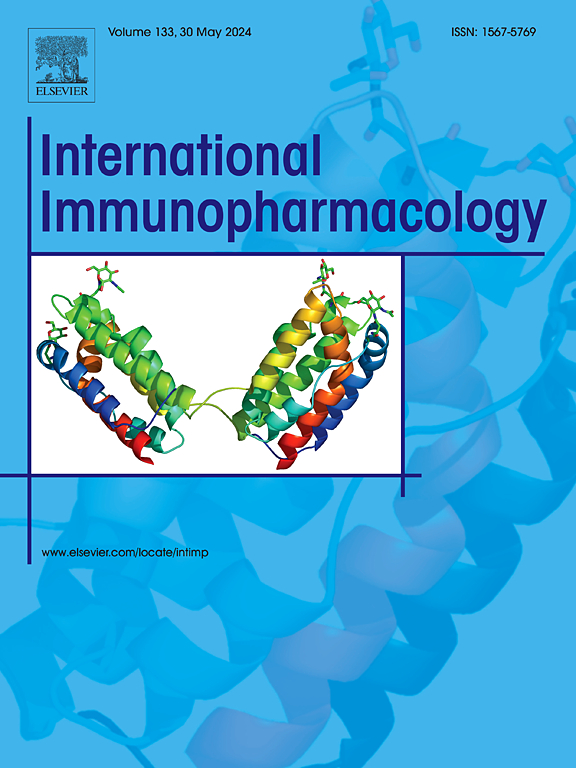IL-27 accelerates diabetic wound healing by modulating macrophage polarization
IF 4.8
2区 医学
Q2 IMMUNOLOGY
引用次数: 0
Abstract
Diabetic foot ulcer (DFU), a serious complication of diabetes, is a life-threatening disease that often leads to lower limb amputation and a shortened lifespan. Interleukin-27 (IL-27) is a member of the IL-12 family and has the potential to exert dual effects on the immune response. The role of IL-27 in diabetic skin wound healing is unknown. The aim of this study was to investigate whether there is abnormal expression of IL-27 in diabetic skin and whether supplementation with IL-27 can promote diabetic wound healing by modulating macrophage polarization. We established a streptozotocin (STZ)-induced diabetic mouse model and constructed diabetic wounds. We assessed protein expression by western blotting (WB) and immunohistochemical (IHC) staining. We also performed hematoxylin–eosin (H&E) staining and Masson's trichrome staining. In the presence of lipopolysaccharide (LPS) and high glucose (HG), we treated the mononuclear macrophage line RAW264.7 and bone marrow-derived macrophages (BMDMs) with IL-27. To assess macrophage polarization, we examined the expression of inducible nitric oxide synthase (iNOS), IL-1β and arginase-1 (Arg-1). To understand the underlying mechanisms, we used macrophage IL-27ra knockout mice to knockout macrophage IL-27 receptors. Our in vivo experiments revealed that the expression of IL-27 in the skin of diabetic mice was significantly decreased and that supplementation with IL-27 promoted diabetic wound healing. In vitro, compared with the LPS group, supplementation with IL-27 alleviated the suppression of multiple cellular functions, such as iNOS and IL-1β expression, cell migration, and phagocytosis, in macrophages after HG exposure. Mechanistically, we found that IL-27 expression was decreased and that the activation of signal transducer and activator of transcription 3 (STAT3) by phosphorylation was inhibited in diabetic skin, leading to an inability of wound macrophages to polarize to an M1 phenotype effectively, which in turn blocked M1-to-M2 polarization of wound macrophages and ultimately delayed wound healing. The present study revealed that supplementation with IL-27 promoted M1-to-M2 polarization of wound macrophages and diabetic wound healing through the IL-27–IL-27Rα–p-STAT3 axis. These findings suggest that IL-27 may be a potential therapeutic target for DFU.

求助全文
约1分钟内获得全文
求助全文
来源期刊
CiteScore
8.40
自引率
3.60%
发文量
935
审稿时长
53 days
期刊介绍:
International Immunopharmacology is the primary vehicle for the publication of original research papers pertinent to the overlapping areas of immunology, pharmacology, cytokine biology, immunotherapy, immunopathology and immunotoxicology. Review articles that encompass these subjects are also welcome.
The subject material appropriate for submission includes:
• Clinical studies employing immunotherapy of any type including the use of: bacterial and chemical agents; thymic hormones, interferon, lymphokines, etc., in transplantation and diseases such as cancer, immunodeficiency, chronic infection and allergic, inflammatory or autoimmune disorders.
• Studies on the mechanisms of action of these agents for specific parameters of immune competence as well as the overall clinical state.
• Pre-clinical animal studies and in vitro studies on mechanisms of action with immunopotentiators, immunomodulators, immunoadjuvants and other pharmacological agents active on cells participating in immune or allergic responses.
• Pharmacological compounds, microbial products and toxicological agents that affect the lymphoid system, and their mechanisms of action.
• Agents that activate genes or modify transcription and translation within the immune response.
• Substances activated, generated, or released through immunologic or related pathways that are pharmacologically active.
• Production, function and regulation of cytokines and their receptors.
• Classical pharmacological studies on the effects of chemokines and bioactive factors released during immunological reactions.

 求助内容:
求助内容: 应助结果提醒方式:
应助结果提醒方式:


